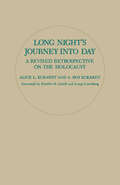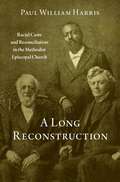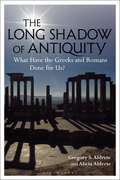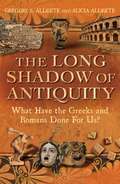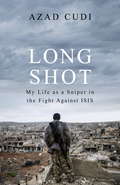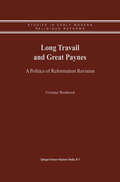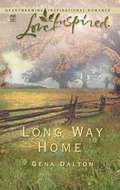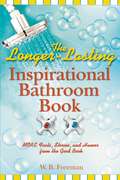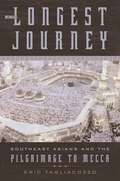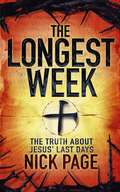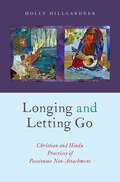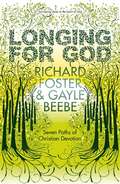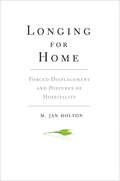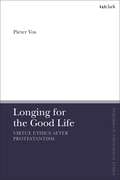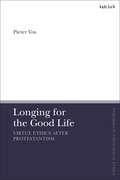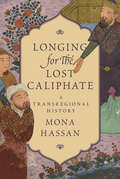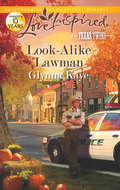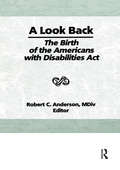- Table View
- List View
Long Night's Journey into Day: A Revised Retrospective on the Holocaust
by Alice L. Eckardt A. Roy Eckardt Irving Greenberg Franklin H. LittellLong Night's Journey Into Day is a stimulating and provocative attempt to deal with the impact and meaning of the Holocaust within contemporary Christian and Jewish thought. To Jews, the Holocaust is the most terrible happening in their history, but it must also be seen as a Christian event. The Eckardts call for a radical rethinking of the Christian faith in the light of the Holocaust, examining such issues as the relation between human and demonic culpability, the charge of God's guilt, and the reality of forgiveness. They clarify the theological meaning of the Holocaust and the responsibility that must be borne for it by the Christian Church, and discuss possible responses to it as exemplified in the writings of selected modern theologians and church councils. This enlarged and revised edition takes into account new topics and developments, including the issue of Austrian responsibility for the Holocaust, the significance and aftermath of Bitburg, and antisemitism in German feminism. More detailed attention is also given to other modern genocides and occasions of humanly-caused mass death. Additional literary, historical, and religious works are considered and appropriate quotations incorporated. The new edition also includes a revised preface, an updated bibliography and two new appendices.
A Long Reconstruction: Racial Caste and Reconciliation in the Methodist Episcopal Church
by Paul William HarrisAfter slavery was abolished, how far would white America go toward including African Americans as full participants in the country's institutions? Conventional historical timelines mark the end of Reconstruction in the year 1877, but the Methodist Episcopal Church continued to wrestle with issues of racial inclusion for decades after political support for racial reform had receded. An 1844 schism over slavery split Methodism into northern and southern branches, but Union victory in the Civil War provided the northern Methodists with the opportunity to send missionaries and teachers into the territory that had been occupied by the Methodist Episcopal Church, South. To a remarkable degree, the M.E. Church succeeded in appealing to freed slaves and white Unionists and thereby built up a biracial membership far surpassing that of any other Protestant denomination. A Long Reconstruction details the denomination's journey with unification and justice. African Americans who joined did so in a spirit of hope that through religious fellowship and cooperation they could gain respect and acceptance and ultimately assume a position of equality and brotherhood with whites. However, as segregation gradually took hold in the South, many northern Methodists evinced the same skepticism as white southerners about the fitness of African Americans for positions of authority and responsibility in an interracial setting. The African American membership was never without strong white allies who helped to sustain the Church's official stance against racial caste but, like the nation as a whole, the M.E. Church placed a growing priority on putting their broken union back together.
A Long Reconstruction: Racial Caste and Reconciliation in the Methodist Episcopal Church
by Paul William HarrisAfter slavery was abolished, how far would white America go toward including African Americans as full participants in the country's institutions? Conventional historical timelines mark the end of Reconstruction in the year 1877, but the Methodist Episcopal Church continued to wrestle with issues of racial inclusion for decades after political support for racial reform had receded. An 1844 schism over slavery split Methodism into northern and southern branches, but Union victory in the Civil War provided the northern Methodists with the opportunity to send missionaries and teachers into the territory that had been occupied by the Methodist Episcopal Church, South. To a remarkable degree, the M.E. Church succeeded in appealing to freed slaves and white Unionists and thereby built up a biracial membership far surpassing that of any other Protestant denomination. A Long Reconstruction details the denomination's journey with unification and justice. African Americans who joined did so in a spirit of hope that through religious fellowship and cooperation they could gain respect and acceptance and ultimately assume a position of equality and brotherhood with whites. However, as segregation gradually took hold in the South, many northern Methodists evinced the same skepticism as white southerners about the fitness of African Americans for positions of authority and responsibility in an interracial setting. The African American membership was never without strong white allies who helped to sustain the Church's official stance against racial caste but, like the nation as a whole, the M.E. Church placed a growing priority on putting their broken union back together.
The Long Shadow of Antiquity: What Have the Greeks and Romans Done for Us?
by Alicia Aldrete Gregory S. AldreteA vivid exploration of the many ways the classical world remains relevant today, this is a passionate justification of why we continue to read about and study the lives and works of the ancient Greeks and Romans.Challenging the way the phrase 'That's just ancient history' is used to dismiss something as being irrelevant, Greg and Alicia Aldrete demonstrate just how much ancient Greece and Rome have influenced and shaped our world today in ways both large and small. From the more commonly known influences on politics, law, literature and timekeeping through to the everyday rituals and routines we take for granted when we exercise, dine, marry and dress, we are rooted in the ancient world. Even the political upheaval, celebrity obsession and blurring of public and private boundaries that we see in current news betray ancient characteristics - now brought to the fore here in a new final chapter.If you have ever wondered how far exactly we still walk in the footsteps of the ancients or wanted to understand how study of the classical world can inform and explain our lives today, this is the book for you.
The Long Shadow of Antiquity: What Have the Greeks and Romans Done for Us?
by Gregory S. Aldrete Alicia AldreteDemocracy? Mathematics? The Calendar? Hospitals? This book is an enlightening look at the myriad ways that the civilizations of ancient Greece and Rome have fundamentally influenced and shaped our modern world. Familiar institutions, rituals, and aspects of everyday modern life are examined to reveal their often surprising classical roots, while the authors explore a selection of the innovations of ancient Greek and Roman civilization to trace how these have developed through history and still affect the world of the twenty-first century. The style is fast-paced and, while drawing on authoritative and current scholarship, the factual information is enlivened with anecdotal details. This book will open the reader's eyes to a new understanding of the world that we live in today.
The Long Shadow of Antiquity: What Have the Greeks and Romans Done for Us?
by Gregory S. Aldrete Alicia AldreteDemocracy? Mathematics? The Calendar? Hospitals? This book is an enlightening look at the myriad ways that the civilizations of ancient Greece and Rome have fundamentally influenced and shaped our modern world. Familiar institutions, rituals, and aspects of everyday modern life are examined to reveal their often surprising classical roots, while the authors explore a selection of the innovations of ancient Greek and Roman civilization to trace how these have developed through history and still affect the world of the twenty-first century. The style is fast-paced and, while drawing on authoritative and current scholarship, the factual information is enlivened with anecdotal details. This book will open the reader's eyes to a new understanding of the world that we live in today.
Long Shot: My Life As a Sniper in the Fight Against ISIS
by Azad CudiAs Syria imploded in civil war in 2011, Kurdish volunteers in the north rose up to free their homeland from centuries of repression and create a progressive sanctuary that they named Rojava. To the medievalists of ISIS, the emergence of a haven of tolerance and democracy on the frontier of their new caliphate was an affront. They amassed 12,000 men, heavy artillery, tanks, mortars and ranks of suicide bombers to crush the uprising. Against them stood 2,500 volunteer fighters armed with 40-year-old rifles. There was only one way for the Kurds to survive. They would have to kill the invaders one by one.A decade earlier, as a 19-year-old conscript into the Iranian army, Azad Cudi had faced being forced to fight his own Kurdish people. Instead he had deserted, seeking asylum in Britain. Now, as he returned to his homeland to help build a new Kurdistan, he found he would have to pick up a gun once more. In September 2014, Azad became one of 17 snipers deployed when ISIS, trying to shatter the Kurds in a decisive battle, besieged the northern city of Kobani.In Long Shot, Azad tells the inside story of how a group of activists and idealists withstood a ferocious assault and, street by street, house by house, took back their land in a victory that was to prove the turning point in the war against ISIS. By turns devastating, inspiring and lyrical, this is an unique account of modern war and of the incalculable price of victory as a few thousand men and women achieved the impossible and kept their dream of freedom alive.
Long Travail and Great Paynes: A Politics of Reformation Revision (Studies in Early Modern Religious Tradition, Culture and Society #1)
by Vivienne WestbrookSome of England's most fascinating Renaissance texts have been forgotten by historians, literary critics and theologians alike. The earliest printed Bibles in the English language provide an astonishingly rich resource for interdisciplinary studies in the 21st century. Long Travail and Great Paynes is a close textual analysis of seven texts that for a wide range of reasons, but no good ones, have been reduced to paratextual entries in general histories of the English Bible. Through extensive collations of her own, Westbrook uncovers the work of seven Renaissance Bible translator-revisers and argues forcefully for a new agenda to replace the outmoded and inappropriate one of evaluating Renaissance Bibles according to the extent of their influence on the 1611 King James Authorised Version. Every sixteenth-century text reflects something of the historical dynamic in which it was created, and English Renaissance Bibles, with their ever-changing text and paratext, have their own unique stories to tell.
Long Way Home: The Mcmahans Of Texas (Mills And Boon Love Inspired Ser. #No. 201)
by Gena DaltonThe only man Jo Lena Speirs had ever loved had finally come home. And though she hadn' t seen Monte McMahan for years, she recognized him the instant she saw him. She would have known him anywhere, just by the way her heart left her body. Jo Lena knew she still loved him, but she had more at stake this time than just her heart.…
The Longer-Lasting Inspirational Bathroom Book: More Facts, Stories, and Humor from the Good Book
by W. B. FreemanShort, pithy pieces--including stories, jokes, little-known facts, brief biographies, quotes, word puzzles, and quizzes--offer fascinating information for anyone with a few minutes to spare. Readers will find that not only are they learning something, they're being uplifted by the entertaining trivia, heartwarming stories, and humorous anecdotes.
The Longest Journey: Southeast Asians and the Pilgrimage to Mecca
by Eric TagliacozzoThe pilgrimage to Mecca, or Hajj, has been a yearly phenomenon of great importance in Muslim lands for well over one thousand years. Each year, millions of pilgrims from throughout the Dar al-Islam, or Islamic world, stretching from Morocco east to Indonesia, make the trip to Mecca as one of the five pillars of their faith. By the end of the nineteenth century, and the beginning of the twentieth, fully half of all pilgrims making the journey in any given year could come from Southeast Asia. The Longest Journey, spanning eleven modern nation-states and seven centuries, is the first book to offer a history of the Hajj from one of Islam's largest and most important regions.
The Longest Journey: Southeast Asians and the Pilgrimage to Mecca
by Eric TagliacozzoThe pilgrimage to Mecca, or Hajj, has been a yearly phenomenon of great importance in Muslim lands for well over one thousand years. Each year, millions of pilgrims from throughout the Dar al-Islam, or Islamic world, stretching from Morocco east to Indonesia, make the trip to Mecca as one of the five pillars of their faith. By the end of the nineteenth century, and the beginning of the twentieth, fully half of all pilgrims making the journey in any given year could come from Southeast Asia. The Longest Journey, spanning eleven modern nation-states and seven centuries, is the first book to offer a history of the Hajj from one of Islam's largest and most important regions.
The Longest Week: The truth about Jesus' last days
by Nick PageWhat really happened during Jesus' final days? It was, historically speaking, nothing much; a death in Jerusalem, a routine execution at the edge of an empire. Yet that execution - and the events surrounding it - were to have a profound effect on the history of the world. The last week of Jesus' life on earth was probably the most important week in history. This book aims to reconstruct the events of those days. From Jesus' entry to Jerusalem on the Sunday, to his resurrection a week later; this book explores the claims and explode the myths. It looks seriously at the evidence of the gospel accounts, without ducking the controversies and contradictions. It focuses on the history rather than the spiritual and theological significance of events and uses archaeological research and detailed Biblical analysis to take the reader through THE LONGEST WEEK.
Longing and Letting Go: Christian and Hindu Practices of Passionate Non-Attachment (AAR Academy Series)
by Holly HillgardnerMirabai, a sixteenth-century Indian princess, wrote passionate love songs to Lord Krishna. Hadewijch, a thirteenth-century European Beguine, wrote of her yearning to become Love itself, to be "God with God." Each woman practiced a full-bodied, sensuously-imaged longing for love; at the same time, each also practiced certain ascetic disciplines. Spanning centuries, continents, and religious traditions, this book juxtaposes Hadewijch's and Mirabai's inextricable energies of longing and letting go as resources for a comparative theology of passionate non-attachment. Within both Hinduism and Christianity, desire and renunciation are often presented as opposites; yet, both Mirabai and Hadewijch, in their own distinct ways, illuminate the integral, tensile relationship between these concepts. Rather than choosing one or the other, each woman's dual practices of longing and letting go not only take her on an inward spiritual journey but also deeply involve her in the beauty and suffering of the wider world. Drawing out crucial differences and intriguing resonances between these two women of faith, Hillgardner develops a Hindu-Christian comparative theology that argues for an interreligious ethic of passionate non-attachment, one capacious and brave enough to hold together our own longings with the desires of others in an interconnected, fragile world.
Longing and Letting Go: Christian and Hindu Practices of Passionate Non-Attachment (AAR Academy Series)
by Holly HillgardnerMirabai, a sixteenth-century Indian princess, wrote passionate love songs to Lord Krishna. Hadewijch, a thirteenth-century European Beguine, wrote of her yearning to become Love itself, to be "God with God." Each woman practiced a full-bodied, sensuously-imaged longing for love; at the same time, each also practiced certain ascetic disciplines. Spanning centuries, continents, and religious traditions, this book juxtaposes Hadewijch's and Mirabai's inextricable energies of longing and letting go as resources for a comparative theology of passionate non-attachment. Within both Hinduism and Christianity, desire and renunciation are often presented as opposites; yet, both Mirabai and Hadewijch, in their own distinct ways, illuminate the integral, tensile relationship between these concepts. Rather than choosing one or the other, each woman's dual practices of longing and letting go not only take her on an inward spiritual journey but also deeply involve her in the beauty and suffering of the wider world. Drawing out crucial differences and intriguing resonances between these two women of faith, Hillgardner develops a Hindu-Christian comparative theology that argues for an interreligious ethic of passionate non-attachment, one capacious and brave enough to hold together our own longings with the desires of others in an interconnected, fragile world.
Longing For God: Seven Paths Of Christian Devotion (Renovare Resources Ser.)
by Richard Foster Gayle BeebeLONGING FOR GOD is a new book from Richard Foster, author of LIFE WITH GOD, CELEBRATION OF DISCIPLINE and PRAYER, written with Gayle Beebe. Over the centuries, people have become alive to the presence of God in various different ways. This book identifies seven primary paths of devotion to God that draw from the great saints of the Church, and provides a history and practice of Christian spirituality that is available to all believers who long to enter into a conversational and redemptive life with God.LONGING FOR GOD blends a reading of the core texts of the Christian faith with 'reflecting and responding' sections that help the reader to use the various texts on their own spiritual journey. Each chapter explores a particular path towards God embodied by various classic spiritual writers, illuminating our understanding of the Christian life.Written in an inviting, interactive style, LONGING FOR GOD examines such themes as the spiritual life as journey; the imitation of Christ; action and contemplation - all of which can draw us closer to the presence of God.
Longing for Home: Forced Displacement and Postures of Hospitality
by M. Jan HoltonWhat is it about the concept of “home” that makes its loss so profound and devastating, and how should the trauma of exile and alienation be approached theologically? M. Jan Holton examines the psychological, social, and theological impact of forced displacement on communities in the Congo and South Sudan and on indigenous Batwa tribespersons in Uganda, as well as on homeless U.S. citizens and on U.S. soldiers returning from the wars in Afghanistan and Iraq. She draws on ethnographic work in Africa, extensive research in practical theology, sociology, and psychology, as well as on professional work and personal experiences in America and abroad. In doing so she explores how forced displacement disrupts one’s connection with the home place and the profound characteristics it fosters that can help people lean toward flourishing spiritually and psychologically throughout their lifetime. Displacement invites a social alienation that can become deeply institutionalized, threatening the moral well being of us all. Longing For Home offers a frame for understanding how communities can respond to refugees and various homeless populations by cultivating hospitality outside of their own comfort zones. This essential study addresses an urgent interreligious global concern and Holton’s thoughtful and compelling work offers a constructive model for a sustained practical response.
Longing for Home (Mirror Lake #4)
by Kathryn SpringerIt seems like the perfect solution: hotel mogul Alex Porter will manage his sister’s small-town bed-and-breakfast while she honeymoons.
Longing for the Good Life: Virtue Ethics After Protestantism (T&T Clark Enquiries in Theological Ethics)
by Pieter VosThis book argues that Protestant theological ethics not only reveals basic virtue ethical characteristics, but also contributes significantly to a viable contemporary virtue ethics. Pieter Vos demonstrates that post-Reformation theological ethics still understands the good in terms of the good life, takes virtues as necessary for living the good life and considers human nature as a source of moral knowledge. Vos approaches Protestant theology as an important bridge between pre-modern virtue ethics, shaped by Aristotle and transformed by Augustine of Hippo, and late modern understandings of morality. The volume covers a range of topics, going from eudaimonism and Calvinist ethics to Reformed scholastic virtue ethics and character formation in the work of Søren Kierkegaard. The author shows how Protestantism has articulated other-centered virtues from a theology of grace, affirmed ordinary life and emphasized the need of transformation of this life and its orders. Engaging with philosophy of the art of living, Neo-Aristotelianism and exemplarist ethics, he develops constructive contributions to a contemporary virtue ethics.
Longing for the Good Life: Virtue Ethics after Protestantism (T&T Clark Enquiries in Theological Ethics)
by Pieter VosThis book argues that Protestant theological ethics not only reveals basic virtue ethical characteristics, but also contributes significantly to a viable contemporary virtue ethics. Pieter Vos demonstrates that post-Reformation theological ethics still understands the good in terms of the good life, takes virtues as necessary for living the good life and considers human nature as a source of moral knowledge. Vos approaches Protestant theology as an important bridge between pre-modern virtue ethics, shaped by Aristotle and transformed by Augustine of Hippo, and late modern understandings of morality. The volume covers a range of topics, going from eudaimonism and Calvinist ethics to Reformed scholastic virtue ethics and character formation in the work of Søren Kierkegaard. The author shows how Protestantism has articulated other-centered virtues from a theology of grace, affirmed ordinary life and emphasized the need of transformation of this life and its orders. Engaging with philosophy of the art of living, Neo-Aristotelianism and exemplarist ethics, he develops constructive contributions to a contemporary virtue ethics.
Longing for the Lost Caliphate: A Transregional History
by Mona HassanIn the United States and Europe, the word "caliphate" has conjured historically romantic and increasingly pernicious associations. Yet the caliphate's significance in Islamic history and Muslim culture remains poorly understood. This book explores the myriad meanings of the caliphate for Muslims around the world through the analytical lens of two key moments of loss in the thirteenth and twentieth centuries. Through extensive primary-source research, Mona Hassan explores the rich constellation of interpretations created by religious scholars, historians, musicians, statesmen, poets, and intellectuals.Hassan fills a scholarly gap regarding Muslim reactions to the destruction of the Abbasid caliphate in Baghdad in 1258 and challenges the notion that the Mongol onslaught signaled an end to the critical engagement of Muslim jurists and intellectuals with the idea of an Islamic caliphate. She also situates Muslim responses to the dramatic abolition of the Ottoman caliphate in 1924 as part of a longer trajectory of transregional cultural memory, revealing commonalities and differences in how modern Muslims have creatively interpreted and reinterpreted their heritage. Hassan examines how poignant memories of the lost caliphate have been evoked in Muslim culture, law, and politics, similar to the losses and repercussions experienced by other religious communities, including the destruction of the Second Temple for Jews and the fall of Rome for Christians.A global history, Longing for the Lost Caliphate delves into why the caliphate has been so important to Muslims in vastly different eras and places.
Longing for the Lost Caliphate: A Transregional History
by Mona HassanIn the United States and Europe, the word "caliphate" has conjured historically romantic and increasingly pernicious associations. Yet the caliphate's significance in Islamic history and Muslim culture remains poorly understood. This book explores the myriad meanings of the caliphate for Muslims around the world through the analytical lens of two key moments of loss in the thirteenth and twentieth centuries. Through extensive primary-source research, Mona Hassan explores the rich constellation of interpretations created by religious scholars, historians, musicians, statesmen, poets, and intellectuals.Hassan fills a scholarly gap regarding Muslim reactions to the destruction of the Abbasid caliphate in Baghdad in 1258 and challenges the notion that the Mongol onslaught signaled an end to the critical engagement of Muslim jurists and intellectuals with the idea of an Islamic caliphate. She also situates Muslim responses to the dramatic abolition of the Ottoman caliphate in 1924 as part of a longer trajectory of transregional cultural memory, revealing commonalities and differences in how modern Muslims have creatively interpreted and reinterpreted their heritage. Hassan examines how poignant memories of the lost caliphate have been evoked in Muslim culture, law, and politics, similar to the losses and repercussions experienced by other religious communities, including the destruction of the Second Temple for Jews and the fall of Rome for Christians.A global history, Longing for the Lost Caliphate delves into why the caliphate has been so important to Muslims in vastly different eras and places.
Look-Alike Lawman (Texas Twins #4)
by Glynna KayeA LITTLE BOY’S HERO When big city cop Grayson Wallace visits an elementary school for career day, he finds his heartstrings unexpectedly tugged by a six-year-old fatherless boy. Gray offers to mentor the child, but widowed mother Elise Lopez wants nothing to do with men in uniform. Now he can’t get the struggling Lopezes off his mind.
A Look Back: The Birth of the Americans with Disabilities Act
by Robert C Anderson”One of my proudest moments as President occurred on July 26, 1990--the day I signed the Americans with Disabilities Act into law. With its passage, a shameful wall of exclusion came tumbling down. This landmark legislation was the culmination of the dedicated efforts of so many, and I salute the bipartisan leadership of the Congress--as well as the countless advocates from all parts of society who contributed to our success. It was a team effort. With the ADA, our country took a dramatic step toward eliminating the physical barriers that existed and the social barriers that were accepted. Much work lies ahead, but I am confident that we will finish the wonderful work already begun. After all, it’s the right thing to do.” --Former President George BushIn 1990, despite resistance from the business sector and state and local governments, disability groups and activists, together with responsive government leaders, succeeded in passing the most significant civil rights bill in decades. A Look Back: The Birth of the Americans with Disabilities Act takes you to the unique moment in American history when persons of many different backgrounds and with different disabilities united to press Congress for full recognition and protection of their rights as American citizens. The ADA recalls the promise of earlier civil rights legislation and advocacy. A Look Back will remind you that people are people before they are disabled and that they deserve to be acknowledged as individuals, rather than stereotyped on the basis of their physical conditions. You’ll witness this firsthand through the inspirational example the Reverend Harold Wilke has set through his own personal struggles, triumphs, and ministry. A witness to the signing of the ADA on the lawn of the White House, he played a key role as a vocal activist in the transformation of self-image for persons with disabilities and in the fight for this bill.In this book, you will see the progress that has been made since the ADA was passed and that, despite the headway made for empowering persons with disabilities, there is much to be done before all individuals are aware of their rights, responsibilities, and protection under the ADA. A Look Back contends that through public education, pastoral care, and open, sensitive congregations, bridges can be built between religion, secular society, and persons with disabilities. This will result in persons with disabilities becoming full participants in daily American life.
A Look Back: The Birth of the Americans with Disabilities Act
by Robert C Anderson”One of my proudest moments as President occurred on July 26, 1990--the day I signed the Americans with Disabilities Act into law. With its passage, a shameful wall of exclusion came tumbling down. This landmark legislation was the culmination of the dedicated efforts of so many, and I salute the bipartisan leadership of the Congress--as well as the countless advocates from all parts of society who contributed to our success. It was a team effort. With the ADA, our country took a dramatic step toward eliminating the physical barriers that existed and the social barriers that were accepted. Much work lies ahead, but I am confident that we will finish the wonderful work already begun. After all, it’s the right thing to do.” --Former President George BushIn 1990, despite resistance from the business sector and state and local governments, disability groups and activists, together with responsive government leaders, succeeded in passing the most significant civil rights bill in decades. A Look Back: The Birth of the Americans with Disabilities Act takes you to the unique moment in American history when persons of many different backgrounds and with different disabilities united to press Congress for full recognition and protection of their rights as American citizens. The ADA recalls the promise of earlier civil rights legislation and advocacy. A Look Back will remind you that people are people before they are disabled and that they deserve to be acknowledged as individuals, rather than stereotyped on the basis of their physical conditions. You’ll witness this firsthand through the inspirational example the Reverend Harold Wilke has set through his own personal struggles, triumphs, and ministry. A witness to the signing of the ADA on the lawn of the White House, he played a key role as a vocal activist in the transformation of self-image for persons with disabilities and in the fight for this bill.In this book, you will see the progress that has been made since the ADA was passed and that, despite the headway made for empowering persons with disabilities, there is much to be done before all individuals are aware of their rights, responsibilities, and protection under the ADA. A Look Back contends that through public education, pastoral care, and open, sensitive congregations, bridges can be built between religion, secular society, and persons with disabilities. This will result in persons with disabilities becoming full participants in daily American life.
